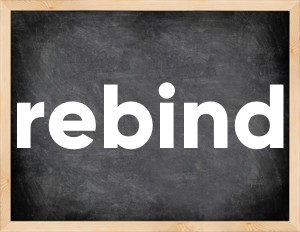 The English verb 'rebind' is pronounced as [ˌriːˈbaɪnd].
The English verb 'rebind' is pronounced as [ˌriːˈbaɪnd].
Related to:
irregular verbs.
3 forms of verb rebind: Infinitive (rebind), Past Simple - (rebound), Past Participle - (rebound).
Here are the past tense forms of the verb rebind
👉 Forms of verb rebind in future and past simple and past participle.
❓ What is the past tense of rebind.
Rebind: Past, Present, and Participle Forms
| Base Form | Past Simple | Past Participle |
|---|---|---|
| rebind [ˌriːˈbaɪnd] |
rebound [rɪˈbaʊnd] |
rebound [rɪˈbaʊnd] |
What are the 2nd and 3rd forms of the verb rebind?
🎓 What are the past simple, future simple, present perfect, past perfect, and future perfect forms of the base form (infinitive) 'rebind'?
Learn the three forms of the English verb 'rebind'
- the first form (V1) is 'rebind' used in present simple and future simple tenses.
- the second form (V2) is 'rebound' used in past simple tense.
- the third form (V3) is 'rebound' used in present perfect and past perfect tenses.
What are the past tense and past participle of rebind?
The past tense and past participle of rebind are: rebind in past simple is rebound, and past participle is rebound.
What is the past tense of rebind?
The past tense of the verb "rebind" is "rebound", and the past participle is "rebound".
Verb Tenses
Past simple — rebind in past simple rebound
(V2).
Future simple — rebind in future simple is rebind (will + V1).
Present Perfect — rebind in present perfect tense is
rebound
(have/has + V3).
Past Perfect — rebind in past perfect tense is
rebound
(had + V3).
rebind regular or irregular verb?
👉 Is 'rebind' a regular or irregular verb? The verb 'rebind' is irregular verb.
Examples of Verb rebind in Sentences